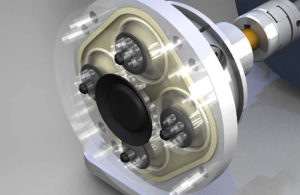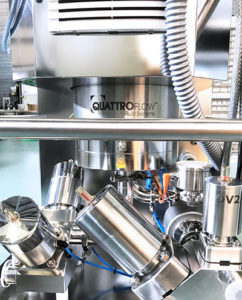Integrated pump controllers aid with operation of quaternary diaphragm pumps

Diaphragm pump technology. Image courtesy of Quattroflow.
While large-scale manufacturing of biopharmaceutical drugs is often fully automated, process development and small-scale manufacturing often still require manual interaction and control steps. This demands continuous monitoring by operators and sometimes results in a lack of consistency in the process. Achieving a higher level of accuracy and consistency is more achievable if the operation’s liquid-processing system possesses automated capabilities that can identify and tune into the proper manufacturing parameters.
A new technology – the integrated pump controller – can optimize pump performance in biotech-manufacturing activities by giving the operator the ability to automatically control such parameters as flow and pressure. This control will make it easier to run simple process steps in biopharma applications more effectively, resulting in better consistency to create a safe, usable end-product.
The challenge

Image courtesy of Quattroflow.
In biopharma production, pumps are used in various critical processing steps, most notably for liquid transfer that requires the creation and adherence to a required flow rate and pressure level. An example of this is the filtration of a liquid where a pressure setpoint must be maintained. While this can be done manually by reading a pressure gauge and adjusting the motor speed if the pressure should venture outside of the acceptable range, this way is time-consuming and lacks the precision that an automated system can provide.
Automated pumps became viable after they were outfitted with a programmable logic controller (PLC). In semi- or fully automated manufacturing processes, the PLC uses sensors to read parameters like the pump’s flow rate and pressure levels during operation and then automatically adjusts those parameters through increases or decreases in the pump’s motor speed if they move out of the required range. However, adding a PLC increases the complexity and cost of the pump’s operation since it requires knowledge of software programming and setup, additional wiring and configuration expenses, and a human-machine interface (HMI).
Benefits of an integrated pump controller
Integrated pump controllers, such as the Q-Control from Quattroflow, are designed to circumvent the difficult installation and setup of a separate PLC, as the proportional-integral-derivative (PID) controller has been integrated into the pump itself while possessing the ability to interface with pressure and flow sensors directly.
This functionality minimizes the need for manual intervention in-process applications. The pump can automatically adjust its motor speed to meet the desired flow and pressure conditions or, in extreme instances, automatically stop the pump’s operation when a high-pressure event occurs, thanks to its internal-alarm function.
Multiple operational modes are possible through an integrated pump controller, such as an autotune function. This function simplifies finding and setting the correct parameters to configure the PID controller, which can be specific depending on process setups. When autotune starts, the pump speed oscillates, allowing the sensor to determine an optimized set of PID parameters to enable more stable and accurate pump control.
This technology is also capable of another feature called process alarm, which can automatically define a specific alarm for every connected sensor and cause the pump to stop if pressure exceeds a particular setpoint. Additional sensors can also be added as needed, such as a level sensor that can stop the pump when the tubing empties.
Andreas Frerix is the product manager for Quattroflow at PSG Germany GmbH. Frerix can be reached at [email protected].